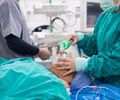The author of a commentary in Canadian Medical Association Journal argues that non-invasive ventilation should be used expeditiously in this setting.
The author of a commentary in CMAJ (Canadian Medical Association Journal) argues that non-invasive ventilation should be used expeditiously in this setting.
Noninvasive ventilation uses a mask interface to ventilate the lungs of patients in respiratory failure, rather than a tube inserted into the trachea. Because suitable candidates for noninvasive ventilation avoid complications associated with endotracheal intubation, they have better outcomes compared to similar patients who are ventilated invasively.Prohibitions against noninvasive ventilation were implemented during the SARS (severe acute respiratory syndrome) outbreak in 2003 because it was thought that flow from the mask increased the risk of infectious transmission to staff. Since then, the World Health Organization, the United Kingdom's National Health Agency, the Hong Kong Lung Association, the American Association of Respiratory Care and Ontario's Provincial Infectious Diseases Advisory Committee have published guidelines that treat noninvasive ventilation as a high-risk procedure.
"During the SARS epidemic, the suggestion that noninvasive ventilation may increase the risk of disease transmission was considered sufficient justification to avoid its use. However in the 6 years since then, no convincing evidence has substantiated that theory. On the other hand, noninvasive ventilation has been proven to save the lives of some patients in acute respiratory failure", writes John McCracken, a respiratory therapist at Peterborough Regional Health Centre in Peterborough Ontario Canada.
"It is in no one's best interest for patients to undergo endotracheal intubation in cases where it could be avoided. In light of the available evidence, the precautionary principle would suggest that it is imprudent for policymakers to await scientific certainty. Noninvasive ventilation can be accomplished using simple portable equipment. "If the demand for sophisticated ICU ventilators threatens to exceed supply during an infectious outbreak, the expeditious use of noninvasive ventilation would help conserve the equipment for those who need it most," concludes the author.
Source-Eurekalert
RAS









